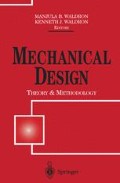Abstract
In this chapter we present a discussion of engineering design and the differences between the design as an artifact and the design as an activity. Hence, different taxonomies of design, as well as different models of the design process, are discussed. Furthermore, their relationships to intelligent computer-aided design are also discussed. The purpose of this chapter is to present different facets of design characterization as discussed in the literature.
Access this chapter
Tax calculation will be finalised at checkout
Purchases are for personal use only
Preview
Unable to display preview. Download preview PDF.
References
Brown, D. C., and Chandrasekaran B. (1985). Expert systems for a class of mechanical design activity. In J. S. Gero (editor) Knowledge Engineering in Computer Aided Design. Amsterdam: North Holland.
Brown, D. C., and Chandrasekaran, B. (1989). Design Problem Solving: Knowledge Structures and Control Strategies. Los Altos, CA: Morgan Kaufman.
Bucciarelli, L. L., and Schon, D. S. (1987). Generic design process in architecture and engineering: A dialog concerning at least two design worlds. In M. Waldron (Ed.). Proceedings from the NSF Workshop on the Design Process, Oakland, CA. 43–67.
Cagan, J., and Agogino, A. M. (1987). Innovative design of mechanical structures from first principles. Artificial Intelligence for Engineering Design, Analysis and Manufacturing, 1 (3), 169–190.
Dixon, J. R. (1987). On research methodology towards a scientific theory of engineering design. Artificial Intelligence for Engineering Design, Analysis and Manufacturing, 1 (3), 145–158.
Dixon, J. R., Guenette, M. J., Irani, R. K., Nielsen, E. H., Orelup, M. F., and Welch, R. V. (1989). Computer-based models of design processes: The evaluation of designs for redesign. In Preprints of the National Science Foundation (NSF) Engineering Design Research Conference, University of Amherst. MA. 491–506.
Dym, C. L. (1994). Engineering Design: A Synthesis of Views. Cambridge University Press, NY.
Dym, C. L., and Levitt, R. E. (1991). Knowledge Based Systems in Engineering. McGraw Hill, NY.
Finger, S., and Dixon, J. R. (1989). A review of research in mechanical engineering design. Part I: descriptive, prescriptive and computer based models of design process. Research in Engineering Design 1 (1), 51–67.
Fitzhorn, P. (1989). In Preprints of the National Science Foundation (NSF) Engi-neering Design Research Conference University of Amherst. MA. 221–231.
French, M. E. (1992). Form, Structure and Mechanisms. London, UK: MacMillan.
Mastow, J. (1985). Towards better models of the design process. AI Magazine Spring, pp. 44–45.
Mittal, S. M., Dym, C. L., and Morjaria, M. (1986). PRIDE: An expert system for the design of paper handling system IEEE Computer, 19 (7), 102–111.
Pahl, G. and Beitz, W. (1984). Engineering Design. London, UK: The Design Council.
Simon H. (1969). The Sciences of the Artificial. Cambridge, MA: The MIT press.
Spillane, M. and Brown, D. (1992). Evaluating design knowledge compilation mech-anisms. In D. Brown et al. (Eds.). Intelligent Computer Aided Design. Amsterdam: North Holland. 351–374.
Suh, N. (1990). The Principles of Design. Oxford, UK: Oxford University Press.
Ullman, D. G., Dietterich, T. G., and Stauffer, L. A. (1988). A model of the mechanical design process based on empirical data: A summary. In J. S. Gero, (Ed.). AI in Engineering Design. New York: Elsevier, 193–215.
Ullman, D. G., Wood, S., and Craig, D. (1990). The importance of drawing in the mechanical design process. Computers and Graphics, 14 (2), 263–274.
Ullman, D. G. (1992a). A taxonomy for mechanical design. Research in Engineering Design, 4 (3), 172–187.
Ullman, D. G. (1992b). The Mechanical Design Process. New York: McGraw Hill. Ulrich, K., and Seering, W. (1989). Conceptual design: synthesis of schematic descrip-tions in mechanical design. Research in Engineering Design, 1 (1), 3–18.
Wallace, K. N., and Hales C. (1987). The application and evaluation of formal design engineering methods. Proceedings of the International Conference on Engineering Design, ICED, Boston, MA: 94–101.
Waldron, M. B. (1988). Tristratal level of design: A foundation for intelligent CAD in mechanical engineering. Proceedings IFIPWG 5.2 Workshop on Intelligent CAD Preprints, 468–475.
Waldron, M. B. (1989). Modeling of the design process. In H. Yoshikawa and D. Gossard (Eds.). Intelligent CAD I. Amsterdam: North Holland, 13–29.
Waldron, M. B. (1990). Understanding design. In H. Yoshikawa and T. Holden (Eds.). Intelligent CAD II. New York: North Holland, 73–88.
Waldron, M. (1991). Design processes and intelligent CAD. In F. Arbab and H. Yoshikawa (Eds.). Intelligent CAD III. Amsterdam: North Holland, 56–75.
Waldron, M. B., and Waldron, K. J. (1988). Position paper on conceptual CAD for mechanical designers. Proceedings of Computers in Engineering, August, 2. 203211.
Waldron, M. B., and Waldron, K. J. (1988). Time study of the design of complex mechanical systems. Design Studies April 9 (2), 95–106.
Waldron, M. B., and Waldron, K. J. (1989). Empirical study on generation of constraints which direct design decisions in conceptual mechanical design. 1989 NSF Engineering Design Conference U Mass. June 15–30.
Waldron, M. B., Waldron, K. J., and D. H. Owen (1989). Use of systemic theory to represent the conceptual mechanical design process. In Newsome et al. (Eds.). Design Theory 88. New York: Springer Verlag, 36–48.
Waldron, M. B. and Vohnout, V. J. (1989). Formalizing knowledge in design for CAD/CAM integration. In A. Samuel (Ed.). Managing Design and Manufacturing. Amsterdam: North Holland. 42–64.
Williams, B. C. (1992). Interaction-based design: constructing novel devices from first principles. In D. Brown et al. (Eds.). Intelligent Computer Aided Design. Amsterdam: North Holland. 255–275.
Editor information
Editors and Affiliations
Rights and permissions
Copyright information
© 1996 Springer Science+Business Media New York
About this chapter
Cite this chapter
Waldron, M.B., Waldron, K.J. (1996). Design Characterizations. In: Waldron, M.B., Waldron, K.J. (eds) Mechanical Design: Theory and Methodology. Springer, New York, NY. https://doi.org/10.1007/978-1-4757-2561-2_4
Download citation
DOI: https://doi.org/10.1007/978-1-4757-2561-2_4
Publisher Name: Springer, New York, NY
Print ISBN: 978-1-4757-2563-6
Online ISBN: 978-1-4757-2561-2
eBook Packages: Springer Book Archive

